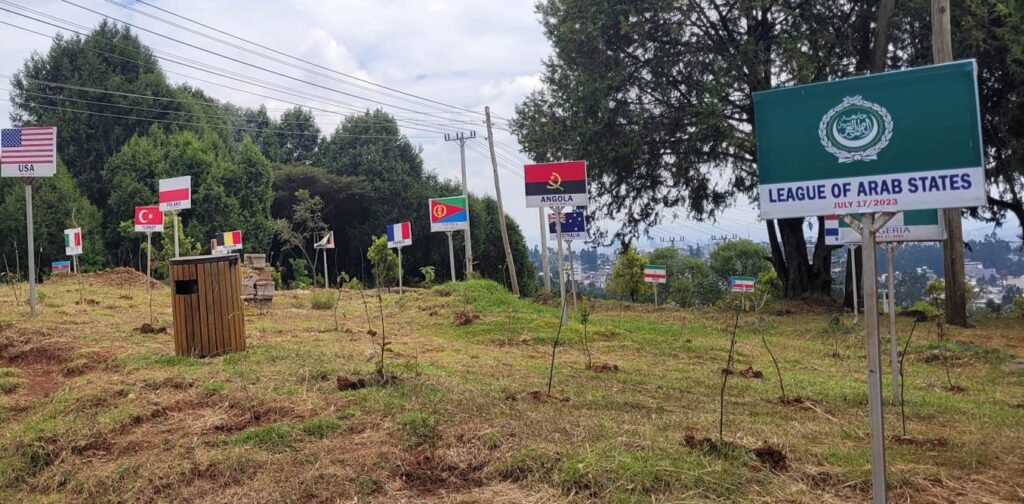In the rural village of Téssékéré, the increasing number and intensity of droughts linked to climate change is making the lives and livelihoods of the local Fulani communities increasingly vulnerable. Here, in the northern Sahel desert region of Senegal (known as the Ferlo), the pastoral population walks over dry, dusty ground with their livestock in search of grazing areas and working borehole water pumps. In favourable years, these farmers can stay in the fields around their local borehole, but climate change is forcing them to move further afield to find pasture to feed their cattle.
In the small Ivory Coast town of Kani, a farmer is concerned about the increase in plantation areas to the detriment of forests, which no longer provide shade. The scarcity and fluctuation of rainfall is altering the sowing periods for rice, maize and yams, and the intermittent nature of the rains is leading to a drop in production quality.
These issues of gradual desertification – where more of the land slowly becomes desert – affects both nature and people. As soil degrades, people migrate to different areas and it can be harder for them to access health services and education while undermining subsistence and production economies, therefore increasing poverty.
As a response, the African Union set up an ambitious continent-wide megaproject in 2007 to address these social-ecological issues and combat poverty. The Great Green Wall initiative is a tree planting restoration project that stretches from Senegal to Djibouti, 5,000 miles (8,000km) across Africa’s Sahel region.
In Téssékéré, bare, scattered plots of fenced-off land covered in cracked soil is now being used to test out techniques for growing seedlings and protect it from further damage by grazing cattle. Winter crops such as peanuts or black-eyed peas are being grown based on an agroecological model, a sustainable farming strategy considering ecological processes.
But large-scale projects like this often don’t consider the needs of local people or places. Our new research shows that the Great Green Wall won’t work effectively unless it considers more localised contexts.
Fulani family moving with their cattle in Téssékéré, Senegal. Élie Pédarros.
At the other end of the continent, the Green Legacy Initiative, a project launched by the Ethiopian government, claims to have planted 566 million trees in one day. In Ivory Coast, which lies outside the original route, local and state authorities see the project as a means of stabilising the ecosystem. However, local populations are concerned that it will be implemented in an ad hoc, unstable and unsustainable manner. In short, the project gives rise to a diversity of opinions and, above all, a multitude of implementation strategies.
Two decades after its launch, the Great Green Wall project is not meeting the expectations of the Intergovernmental Panel on Climate Change and other independent experts, especially regarding forest cover increase in the area and global implementation of the project.
In 2021, the French president Emmanuel Macron launched the Great Green Wall accelerator to bring the project into line with a new political timeframe to speed it up.
With investment of US$19 billion (£14.82 billion), more action, such as land restoration and investment in farming, can be rolled out across Africa, so the focus is now on large-scale change rather than localised projects. The Great Green Wall has become an umbrella term, a brand encompassing many development projects managed by different international and intergovernmental organisations. This is at odds with our research findings confirming that the ambitious aims of the project aren’t being implemented locally in an effective manner.
This “takeover” of the project by developed countries prompts us to question what the project has now become and its ability to meet its original purpose.
Set to fail?
The Great Green Wall will fail unless it returns to its original aim of being a pan-African project made up of a multitude of aspirations, imaginations and local social-ecological contexts. Project funding alone is not enough to ensure the success of the project – it needs local appropriation. Success should not be measured solely in terms of how many trees are being planted, but on whether local people see a positive difference from the project in their areas and on their lives.
From Senegal to Ethiopia, our research shows that the Great Green Wall implies a diversity of world views. The project is therefore implemented specifically in each region, in each country, to form a project mosaic. The initiative loses its substance and its capacity for local appropriation when homogenised and globalised to fit into external political agendas.
An agroecological initiative like this one only works when it involves the people living on the ground. More than simply an eco-project, it is a diverse, pan-African and locally embedded social-ecological initiative with scope to make substantial change at scale if executed well.
Don’t have time to read about climate change as much as you’d like?
Get a weekly roundup in your inbox instead. Every Wednesday, The Conversation’s environment editor writes Imagine, a short email that goes a little deeper into just one climate issue. Join the 35,000+ readers who’ve subscribed so far.
Source link : https://theconversation.com/africas-great-green-wall-will-only-combat-desertification-and-poverty-by-harnessing-local-solutions-235240
Author :
Publish date : 2024-10-08 12:33:57
Copyright for syndicated content belongs to the linked Source.
